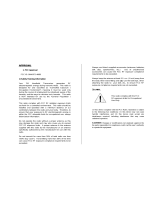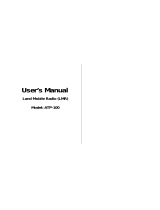Page is loading ...

User’s Manual
FM HANDHELD TRANSCEIVER
Model: AQ-40B

APPROVAL
1. FCC Approval
FCC ID :
1) Safety Training Information
Your FM Handheld Transceiver generates RF
electromagnetic energy during transmit mode. This radio is
designed for and classified as “Controlled Exposure /
Occupation Environment”, meaning it must be used only
during the course of employment by individuals aware of the
hazards, and the ways to minimize such hazards. This radio
is NOT intended for use by the “General Population /
Uncontrolled Environment.
This radio complies with FCC RF radiation exposure limits
set forth for a controlled environment. This radio should be
installed and operated with a minimum distance of 2.5
centimeters between the radio and your body. Therefore, to
ensure that your exposure to RF electromagnetic energy is
within the FCC allowable limits for occupational use, always
follow below information.
Do not operate the radio without a proper antenna as this
may damage the radio and may also cause you to exceed
FCC RF exposure limits. A proper antenna is the antenna
supplied with this radio by the manufacturer or an antenna
specifically authorized by the manufacturer for use with this
radio.
Do not transmit for more than 50% of total radio use time
(“50% duty cycle”). Transmitting more than 50% of the time
can cause FCC RF exposure compliance requirements to be
exceeded.
Always use Airtech supplied accessories (antennas, batteries,
belt clips, speaker/mics, etc.). Use of unauthorized
accessories can cause the FCC RF exposure compliance
requirements to be exceeded.
Always keep the antenna at least 2.5 cm (1 inch) away from
the body when transmitting and only use the belt-clips, when
attaching the radio to your belt, etc., to ensure FCC RF
exposure compliance requirements are not exceeded.
2) LABEL
This radio complies with the FCC RF exposure
limits for Occupational Use Only.
3

CONTENTS
GENERAL FEATURES.................................................2
UNPACKING.................................................................3
OPTIONAL ACCESSORIES.........................................4
GETTING READY.........................................................4
DESCRIPTION..............................................................5
OPERATION.................................................................5
CHARGER AND BATTERY..........................................7
General Features
1. Compact design & size
(125(W)x55(H)x40(D), 350.7g with high capable battery)
2. Heavy duty durable construction
3. 128 channels
4. 38 CTCSS/ 83 CDCSS/ 83 INVERR CDCSS
5. PC Programmable, transferable by cloning
6. Time-out timer (TOT)
7. Busy Lockout (BCLO)
8. Battery saving mode
9. Low battery alert
10. DTMF ANI
11. Transmit output power High/Low
DC 7.5V Ni-Mh battery
2
1

Unpacking
Unpack and check that all items have been enclosed.
Packing contents: ±radio ↑antenna →battery pack
(1,650 mAH) ↓belt clip °hand strap ±charger ″user’s manual
Optional
Accessories External speaker/microphone
1. Additional battery pack
Getting Ready
1. Installation and Removal, Belt Clip
Installation: Align the belt clip with the plastic slots of
the battery pack. Slide the belt clip onto the battery pack,
pushing firmly until a click heard.
Removal: Hold up the belt clip release tab with a
fingernail or a coin (or like instrument). While holding up
the release tab, slide the belt clip out and away from the
battery pack.
2. Installation and Removal, Battery Pack
Installation: Turn off the transceiver. Hold the
transceiver with the back of the unit
facing up. Place the battery pack against
the back of the transceiver so that the
tabs on the transceiver engage the four
openings in the battery pack. Slide the
battery pack toward the top of the
transceiver until a click heard.
Removal: Turn off the transceiver. Hold the radio with
the back of the unit facing up. With the thumbnail of your
other hand slide the latch lever down. While holding the
latch lever down, slide the battery pack down toward the
bottom of the transceiver.
Separate the battery pack from
the transceiver.
3. Installation Antenna
Rotate the antenna clockwise
until it is seated firmly.
*. Before starting operation, make
sure the battery is fully charged.
3
4

Description
Operation
1. Power on / off
On : Holding down on/off switch for 2 seconds, LED lamp
would be flashed red and green alternately. When LCD
window is lighted, it is Okay.
Off : Holding down on/off switch for 2 seconds, LED Lamp
will be flashed red and green alternately. When LCD window
light goes off, it is Okay.
2. Audio Volume Control
Audio volume is increasedwhen rotating volume switch
clockwise.
Audio volume is decreased when rotating the volume
switch counter-clock.
3. Channel Selection:
Possible to channel selection when rotating volume knob
clockwise or counter clock wise while holding down
Function switch.
4. Transmit:
Hold down the PTT Button ⓗ and talk into the MIC at
1-2 in distance. The LED lights red on transmitting.
Release the PTT button ⓗ to receive.
5. Receive:
Choose the desired channel by rotate right/left switch ⓚ.
The LED lights green on receiving. In case the signal
doesn’t match the sub–tone the green LED will blink.
6. Monitor:
Press to monitor. Pressing the monitor button for more
than 2 seconds will cause continuous monitor condition.
To release the monitor mode, press and release the
monitor button quickly.
7. Transmit operation during scan
①. If the radio is programmed in PTT channel at
scanning is home channel: TX will occur on the
channel the scan started.
②. If the radio is programmed in PTT channel at
scanning is last busy channel: TX will occur on the last
busy channel
8. TX ANI
If the radio was initially programmed for this feature
pressing the PTT will cause a DTMF code to be send
that can identify the sending radio.
9. 2/5 Tone Decode (Selcall)
During initial radio programming by the technician this radio
5 4
6
6

can be configured for several different types of decode
operation. If a channel is selected that has Selcall
activated the radio will be muted until the proper signal is
received. When this occurs the radio can sound a ringing
type alert signal or a voice message maybe heard.
Depending upon the initial programming, pressing the
PTT may cause an automatic identifier to be sent. When
programmed for Selcall pressing the monitor and function
buttons at the same time can cause the Selcall mode to
be cancelled and generate an automatic identification.
Please have your radio technician or dispatcher fully
explain this operation.
Charger and Battery
1. Battery (Ni-Mh)
Voltage & Current DC 7.5V , 1650mA
Duty time (5-5-90) Over 8 hrs
2. Charger
Input power CHARGER INPUT DA 12V
(120VAC)ADAPTOR
INPUT POWER
Operating temperature 10-30 deg. C
Connect the charger to an appropriate outlet (120VAC
ADAPOR). Turn the transceiver power off and place the radio
into the front socket of the charger. The red light illuminates
during charging and the green light comes on when the
charge is complete. When you place two batteries in the
charger at the same time, the front battery will charge first.
The rear battery will begin charging when the front battery
charge is complete.
On Charging
Red
Blinking Abnormal battery
Green On Fully charged
On Stand-by for charging (rear cup) Orange
Blinking Discharging
z When you put a battery in the rear cup of the charger the
charger checks the voltage. If voltage is over 7.4V, the
charger starts discharging for 4 minutes then checks
again. If voltage is still more than 7V, it discharges until
the voltage is 6V then starts charging.
7
8
/



